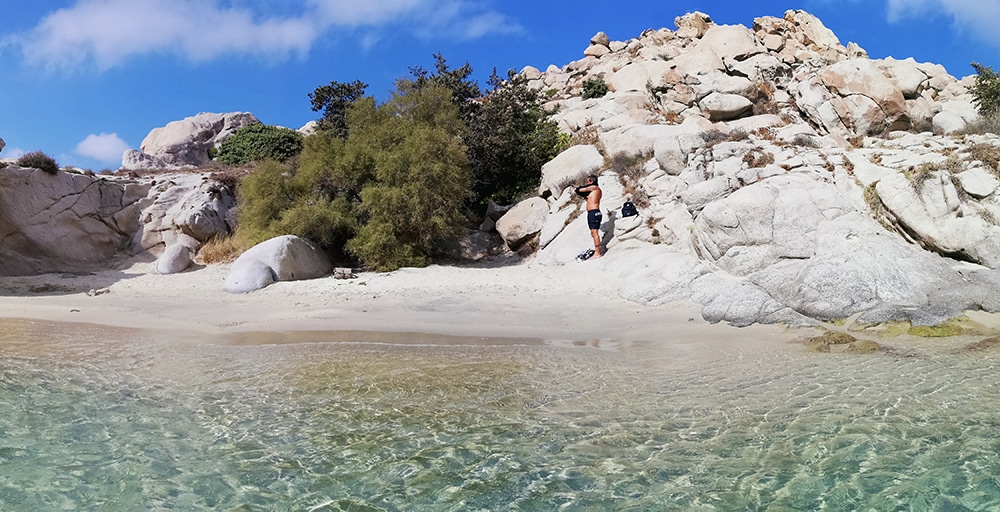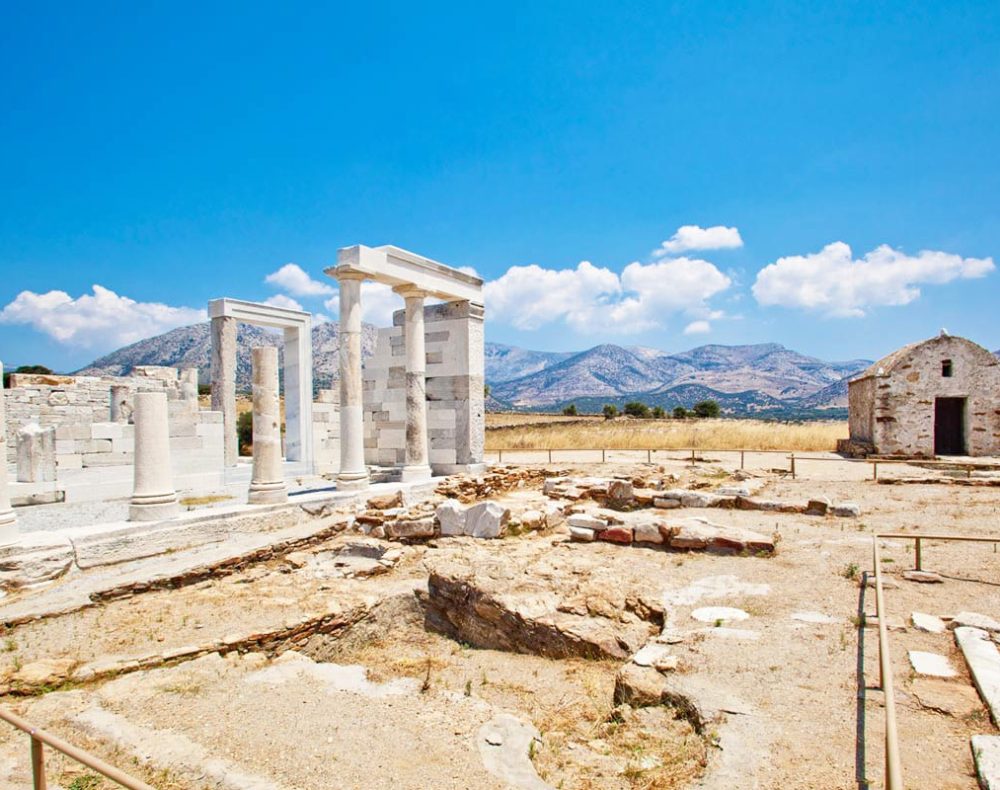What to see in Naxos
The Island
The inhabitants are about 20,000, of which about 1/3 live in Chora, the capital and main port of the island; the second most important town is Filoti, in the island. The main activities of the population, after tourism, are agriculture and livestock. Fishing occupies an insignificant part. Naxos is the largest island of the Cyclades archipelago (from the Greek “Kiklos” = circle, the name of the archipelago comes from the fact that its islands form a circle around the sacred island of Delos, near Mykonos).
From north to south it is about 37 km long, while from west to east it is about 23 km wide; the coastal perimeter is 148 km. In addition to being the most fertile and the richest in water, it is also the most mountainous: a chain of imposing peaks culminates with the highest point of the archipelago, Mount Zeus, which exceeds 1000 meters, on which it is admire the sunrise and the magnificent panorama of the Cyclades islands around Naxos, on the clearest days there are more than 30 islands!. The island produces olives, grapes, fruits, wheat and the famous potatoes which it exports all over Greece, as well as delicious jams and delicious honey. Since ancient times, it has been famous for the large amount of white marble extracted from its mountains. The main port, Chora, is located on the west side, while the port of Moutsouna, on the east coast, was reserved for ships carrying marble, granite and emery extracted from the interior mines. Today this transport activity is in crisis and the city of Moutsouna is establishing itself as a small seaside resort.
The discreet road network covers the northern and central part of the island; the rugged and mountainous southern area is inaccessible except by all-terrain vehicles, except for the coastal road that connects to the magnificent southwestern beaches. The public service is discreet and widespread on the beaches of the south west coast, less frequent for the other towns of the island and the other seaside resorts. The bus station and the bus timetable information office (KTEL) are located in the square in front of the main port pier; outside, a notice board lists bus routes and return times.
The island is a wonderful place to explore, even on foot: many ancient paths connect villages, churches and archaeological sites to discover. At the ZOOM stationery / bookstore on the harbor promenade you will find very detailed maps of the island and a guide.




CHORA
The capital, to the west of the island, still retains a strong medieval imprint. Behind the modern architecture of the buildings that overlook the port and the lively promenade (called “paralia”), a second scenario opens up to be discovered: from the Venetian, Turkish, Byzantine casbahs to climbing in a labyrinth of white streets up to in Kastro, a well-kept medieval citadel that holds surprises around every corner. The upper part of the town, in fact, at the end of a fertile plain, is crowned by the Venetian castle complex, in which tall houses, sometimes in the form of towers and with entrances decorated with the coats of arms of noble families , draw on the Byzantine tradition with elements from Western Europe.
what to see at chora
PORTARA surreal and gigantic marble door that frames the sea, is the symbol of Naxos. It does not lead to a palace or an enclosed space, but is all that remains of the ancient temple dedicated to the god Apollo, dating from around 2500 years ago, left unfinished and facing the sacred island of Delos . It is located on the islet of Palatia, connected by an umbilical cord of land to the Chora. This islet, in addition to its historical and archaeological importance, is a unique place to enjoy the sunset over the Aegean Sea and, on a clear day, to enjoy the view of the islands of Paros, Delos, Mykonos and Syros.
KASTRO once you leave the seafront you enter a maze of white alleys, some covered, others unpredictable with no exits, stairs, passages, in the old popular district of Burgos. Climb to the medieval village built eight centuries ago by Marco Sanudo, grandson of a Venetian Doge. He made this town the capital of his duchy and there are still some stately homes built by the Venetians, many with well-kept hidden gardens and coats of arms of the former owners’ noble families. It is said that at the time there were 13 towers, today only one remains, that of Crispi, named after the last dukes of the island. It is also known as Glezos Tower, named after the last owners who donated it to the Greek state.
The CATHOLIC CATHEDRAL is located at the highest point of Kastro Hill, in one of the most beautiful squares. In this small church there is an ancient Byzantine icon from the 12th century, the longest in the world, double: on one side a beautiful Madonna with the Child in her arms and on the back the image of St. John. There is also a very valuable and rare icon of the Virgin breastfeeding her baby: there are only 4 of them in the world, the other 3 are located in Moscow, Germany and the Vatican. There are also the tombstones of the Grimaldi family of Montecarlo. Mass: 9:30 a.m. on Sundays and 6:30 p.m. on weekdays.
The ARCHAEOLOGICAL MUSEUM is a valuable collection of Cycladic idols, Hellenistic vases and mosaics; once the home of the Ecole de Commerce and the Collège Français where Nikos Kazantzakis, the author of Zorba the Greek, studied. The most important pieces in the museum include the figure of a seated woman and that of a man holding an object; The mosaic placed on the terrace outside the museum is also interesting, from where you can enjoy a beautiful view of the mountains surrounding the Chora.
VENETIAN MUSEUM was founded in 1999 and is located in the palace of the Della Rocca Barozzi family. Its history begins at the end of the IV Crusade (1207) with the installation of the Venetians in Naxos. The museum once housed the consulate of Venice and was later the home of several noble families. The current owners (descendants of the Della Rocca-Barozzi family) have decided to open their house to the public: furniture, jewelry, everyday objects and other relics are displayed there. The museum is open every day from 10 a.m. to 3 p.m. and in high season also at the end of the afternoon. In summer concerts of classical music or folk music and dances of Naxos take place in its garden within the walls (usually on Wednesday evenings); the setting with a panoramic view of the Portara and the sea at sunset is suggestive.




not to be missed
on the rest of the island
The KOUROS are three mysterious marble giants, a unique case in all of Greece, left unfinished and dating from the 7th century. Before Christ.; the largest (10 meters) is located in the village of Apollonas, in the far north of the island; the second (about 7 meters) is located in the vegetable garden of a peasant family in the Melanes region. There is also a third near that of Mélanes, in the middle of the countryside, now easily accessible because it is marked out.
PANAGIA DROSSIANÍ in the locality of Monì, is one of the most important and oldest sanctuaries in all of the Balkans, with frescoes dating back to the 7th century; it was the abbey church of a monastery.
TEMPLE OF DEMETRA in the locality of Sangrì, are the remains of an imposing Ionic temple. It is famous for being covered with transparent marble tiles which produce a diffused light effect inside; some can be seen in the small adjoining museum.
traditional villages
HALKÍ famous for its beautiful neoclassical houses and for being the seat of the old Vallindras distillery, founded in 1896, where Kitron is still produced from cedar leaves; nearby there are two very old Byzantine churches with frescoes. The local women’s craft shop, where you will see an old wooden frame still in use, and the ceramic painting and olive wood work shop are also interesting.
KALÓXILOS just after Halkì, on the road to Filoti, there is a detour to the left towards this small and charming village little known to tourists, where time seems to stand still. Park in front of the large church on the right and continue on foot. Just opposite you will find an old house, recently renovated maintaining its original features. There you will find Florios, the friendly owner, who with great pleasure (and with great pride!), will show you the house of his ancestors, now transformed into a small folk museum. Opening hours: 9 a.m. to 4 p.m., admission €2 adults, children under 10 free.
FILÓTI second city of the island after Chora, dominated by Mount Zeus; once stronghold of the Barozzi family, whose crenellated castle can still be admired, it has some Venetian houses and the beautiful old church of Nostra Signora Filotissa. The meeting point of the village is the pretty square with the huge plane tree and the rooms overlooking it.
APÍRANTHOS known as the “land of marble”, capital of folklore, famous for its fabrics, its popular poems, its wine and the strange dialect that mixes Cretan and Byzantine idioms; in the walkable area is the church of Agia Kiriaki which preserves paintings from the iconoclastic period. There are two Venetian castles, Zevgoli and Bardana, with the lions of San Marco; interesting the folklore museum in the pretty square and the small archaeological (free) and geological (free entry with the same ticket as the folklore one). The small point of sale of the cooperative of the women of work and hand embroidery of this village located at the beginning of the main street is worth the detour.
APÓLLONAS small port with characteristic taverns on the sea, in the extreme north of the island, famous for the greatest Kouros. Suggesting the way to go, sometimes overlooking the sea with breathtaking sea views. Along the way, Abram’s Cove and its namesake beach are graceful.
KORONOS charming mountain village clinging to the walls of a ravine, near the old emery mines; famous for its pure water springs and for the excellent little taverna (see the ‘Restaurants’ chapter below).
POTAMIÁ literally “rivers” in Greek, these 3 villages (Ano Potamià, Mesi Potamià and Kato Potamià) are rich in water and each house has a lush garden; the path on foot that connects them is very pleasant and shady.
MÈLANES located in a very green valley, in an expanse of olive groves and orchards; famous for the proximity of the other two “Kouros” of the island. The evocative ruins of the ancient monastery of Kalamitsia are nearby. Its many famous taverns whose specialties are ….. the rooster and the rabbit!
MOUTSOUNA, a small port on the east coast, was reserved for ships transporting marble, granite and emery extracted from inland mines; today it is famous for its tavernas overlooking the marina which serve excellent fresh fish (…watch the prices!).








